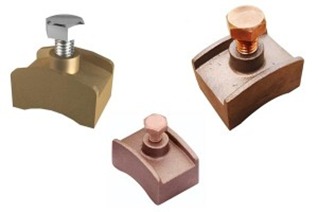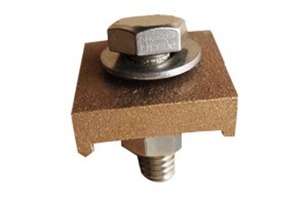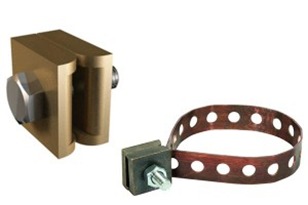Brass Bonds
DIFFERENT TYPES OF BRASS EARTHING BONDS
• Electrical bonding is the practice of intentionally electrically connecting all exposed metallic noncurrent items in a room or building as protection from electric shock. If a failure of electrical insulation occurs, all bonded metal objects in the room will have substantially the same electrical potential, so that a person of the room cannot touch two objects with significantly different potentials. Even if the connection to a distant earth/ground is lost, the person will be protected from dangerous potential differences.
• In a building with electricity it is normal for safety reasons to connect all metal objects such as pipes together to the mains earth to form an equipotential zone. This is done in the developed countries like U.S.A, U.K etc because many buildings are supplied with a single phase supply cable where the neutral and earth conductors are combined. Close to the electricity meter this conductor is divided into two, the earth terminal and the wire going to the neutral bus bar in the consumer unit. In the event of a break in a neutral connection this earth terminal provided by the supply company will be at a potential (relative to the true earth) which is the same as the live wire coming to the home.
How the Earth Protects
• In a system with a grounded neutral, connecting all non-current-carrying metallic parts of equipment
to earth ground at the main service panel, will ensure that current due to faults (such as a "hot" wire
touching the frame or chassis of the device) will be diverted to earth. In a TN system where there is a
direct connection from the installation earth to the transformer neutral, Earthing will allow the branch
circuit over-current protection (a fuse or circuit breaker) to detect the fault rapidly and interrupt the
circuit.
• In the case of a TT system where the impedance is high due to the lack of direct connection to the
transformer neutral, an RCD (Residual-Current Device, sometimes known as a Residual Current Circuit Breaker or Ground Fault Circuit Interrupter) must be used to provide disconnection. RCDs are
also used in other situations where rapid disconnection of small earth faults (including a human
touching a live wire by accident, or damage) is desired.
Technical Details
| Item | Material | Length | Width | Height |
|---|---|---|---|---|
| Brass Earthing Bonds | Brass, Copper, Aluminium | 33 mm | 55 mm | 13 mm |
WATERMAIN PIPE BOND

WATERMAIN PIPE BOND
• Water main pipe bond has application in bonding of metallic water main pipe & copper Tape to the Earthing or Lightning protection system.
| Maximum Tape Width | Conductor Material | Weight Each |
|---|---|---|
| 26 | Copper | 0.26kg |
B BOND 20

B BOND 20
• Used for bonding Tape to steel structures.
Product Information :
• ‘B’ Type Bond connections are designed to bond either copper or aluminium conductor to flat metal
surfaces.
Features :
• Material : Gunmetal or Aluminium (body), Stainless Steel (bolt)
• Standard : BS:EN 62561-1 Class H, BS 7430
• Tightening torque : 17Nm
RWP BOND

RWP BOND
• RWP type Bond connections are designed to connect flat conductor to circular objects
ie pipework and hand rails etc.
Material: Gunmetal. Standards: BS 7430.
| Maximum Tape Width | Bolt Size | Conductor Material | Weight Each |
|---|---|---|---|
| 26 mm | M10 | Copper | 0.12kg |
| 26 mm | M10 | Aluminium | 0.07kg |